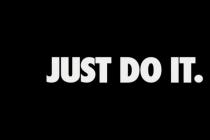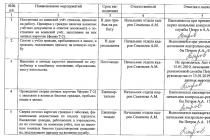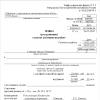One of the main tasks of strategic management is the implementation of the enterprise development strategy. The implementation of the strategy is carried out by developing intra-company plans (strategic, medium-term and tactical), as well as a system of budgets.
The strategic plan is a tool for implementing the concept of purposeful behavior of the organization, as well as the implementation of its strategic set. The strategic plan has a complex internal structure, reflecting the multi-purpose nature of the enterprise's activities and necessitating the formation of a system of plans and programs.
In its structure, the strategic plan is a formalized planning document, which expresses the strategic set of the enterprise, specified in separate planning tasks. The necessary components of the strategic plan are supporting plans, programs, estimates, budgets. Tools for the implementation of strategic plans and programs are current and operational plans.
The medium-term planning system provides for determining the sequence of achieving strategic goals (stages of implementing strategic plans), taking into account the prospects for the development of market conditions, the predicted dynamics of consumer demand, and the available resource potential.
Current plans(tactics) are short-term strategies consistent with the strategic set. Current plans are drawn up with the aim of concretizing, supplementing and adjusting strategic plans, taking into account the specific situation that prevailed at the beginning of the planning period. Distinctive features and characteristics of tactical plans:
Tactical plans are developed in full accordance with the strategic plans in their development.
Strategic plans are almost always developed at the highest levels of management, while tactical plans most often developed at the level of middle managers.
Tactical plans, as a rule, are designed for a shorter period of time than strategic ones, so the results of their implementation appear relatively quickly, which allows you to quickly respond to identified deviations.
One of necessary conditions implementation of the strategy is the mobilization and allocation of strategic resources. Budgets are used to determine what resources are available. The budget is a method of allocating resources, characterized quantitatively, to achieve goals, also presented in quantitative form.
The advantage of budgets is that they not only answer the question of how much and what resources are required, but also show the sources of their replenishment. That is, the budget (cash flow forecast) consists of revenue and expenditure parts, and in the optimal budget, revenue part is equal to the expenditure.
In addition to the overall budget of the enterprise, covering all aspects of business operations, budgets are prepared for each individual division, as well as the main functional areas of the firm (production, individual capital investment projects and marketing).
The adaptive nature of strategic plans implies periodic adjustment of budgets in accordance with changing goals or strategy. It is important to create a permanent mechanism for the redistribution of resources. Implementers should be prepared to transfer resources to another area of activity to support new strategic initiatives and priorities. New strategies require a significant redistribution of the budget. Thus, through the system of budgets, the implementation of the tactical plans of the enterprise is carried out.
One of the most significant moments in the implementation of the strategy is the development of a motivation technique that develops in the staff a comprehensive sense of responsibility and success in doing work. The variety of approaches to motivation and encouragement of employees is quite large.
The mechanism of staff motivation includes the provision of additional awards or prizes, universal recognition, constructive criticism, greater (or less) responsibility, increased (or reduced) control over work and the provision of the right to make independent decisions, offering better working conditions or appointment to more attractive regions, additional payments for the work of the entire team and tangible material incentives, etc.
Senior and middle managers should be aware that the policy and technique of motivation and encouragement must be used creatively and be closely linked to the factors and goals necessary for the successful implementation of the strategy. However, the question of how and what kind of incentives should be used depends on the complexity of the implementation of the strategic plan. The better the manager understands what motivates the employee the most, the more he relies on the incentive system as an instrument of the strategic plan, the stronger the employee's interest in the results of his activities.
When developing a system of incentives and rewards, the following should be considered:
Cash remuneration should be a significant portion of all employee compensation payments.
The incentive system should apply to all managers and employees, and not be limited to the top management staff.
The reward system must be strictly structured and carefully analyzed.
Remuneration should be associated with the achievement of only those goals that are defined in the strategic plan.
Evaluation of the employee's achievement of the set goals should be carried out on the basis of specific results of his activities.
Payments should be directly linked to the evaluation of the implementation of the strategic plan. If the goal of the strategic plan is to become a low-cost producer, then the reward system should encourage activities that lead to lower costs. If the growth of the company is associated with the introduction of new products, the amount of bonuses should be calculated as part of the profit received from these products.
Information and analytical support of the development process and implementation of the strategy
Strategic decisions directly determine the fate of the enterprise, affect its development and viability. The validity of decisions made depends on the information on which they are based. Existing information systems provide the management of enterprises with information focused mainly on the internal environment - technology, organization of production, financial and economic indicators, etc. and characterize it.
Information about the external environment is fragmented, non-systemic. As a rule, there is no information about economic trends, scientific and technological achievements, markets and competition on them, consumers and their requirements. In addition, there is a lack of socio-political information, the collection and analysis of which even research institutes are not doing enough. All this leads to the dominance of subjective ideas about the situation at the enterprise and beyond, which does not allow making reasonable forecasts and making strategic decisions on adapting to the future and shaping the future itself.
The strategic information needs of the enterprise cover everything that can affect the activities of the enterprise in the long term. This is data related to changes in the internal and external environment, including force majeure, including information about events that are not directly related to the activities of the enterprise.
The specific differences of strategic information include:
focus not so much on the microenvironment of the enterprise as on the external environment of direct and indirect influence;
analysis of information in terms of representative probability;
predictive nature of the results of information processing;
a high probability of subjectivity in explaining the characteristics of indicators;
the cross-functional nature of information (the need for information support for individual business processes), which leads to the handling of large volumes of analytical and financial information.
Strategic activity requires reliable information support in the form of strategic databases, assumptions and forecasts. The creation of such support includes not only the collection of large amounts of information and its processing. The Strategic Data Base (BSD) is a concise systematic description of the most significant strategic elements. It is used to assess the current state, is used to determine the manifestations of processes in the future and to make strategic decisions.
The BSD contains information about the influence of individual components and factors of the process of strategic analysis and management on the formation of strategic alternatives, as well as information that allows you to make certain decisions on certain alternative options. That is, the BSD can be interpreted as a subsystem for supporting management decisions. The BSD is formed with the help of targeted collections of information that come from various sources and are, in essence, the process of converting a set of data into strategic information based on their analytical processing with a focus on specific use in the process of developing and implementing strategic decisions. Well-formed and up-to-date strategic databases are the basis for strategic planning and control.
Calendar plan
The tools for implementing the strategy are the following:
1. Establishing partnerships with distributors and megayacht crews.
2. Opening of new offices and selection of highly qualified personnel
3. Complication of the organizational structure. Establishment of offices subordinate to the main office.
4. Technology - the work of the technology department to develop and improve software and expansion of the services offered.
5. Management - organizing the implementation of strategies, constant monitoring and search for operational solutions.
The business strategy will be implemented through the direct creation of offices for the reception of orders in ports. It does not require large capital investments and will bring a large payback. Crews will interact with NSY directly and this will increase the confidence of buyers in the reliability of this company.
Chapter 7 Strategic Control
The task of strategic control is to understand whether the implementation of the strategy will lead to the achievement of the goals. This task determines how the system of strategic control is built. Everyday, consistent, deep control over the work of each employee of the NSY company and the entire team as a whole is important function management regardless of the form of ownership. Without well-established control, it is impossible to achieve coordinated actions of the team in the implementation of the company's mission and its long-term program, the organization of clear interaction between all employees. The behavior of people, of course, is not the only factor that determines the effectiveness of control. In order for the control to perform its true task, i.e. to ensure the achievement of the goals of the organization, he must have several important properties. Control is effective if it is strategic, aimed at assessing the achievement of specific results, timely, flexible, simple and economical. If a subordinate has any problems with the control system, then he should be able to openly discuss them without fear that the management will be offended by this. The manager exercising control in the organization should frankly discuss with his subordinates what values of expected results will be applied as standards in each area of control. Such communication should increase the likelihood that employees will accurately understand the true purpose of control and help identify hidden gaps in the control system that are not obvious to its creators from the top management of the company. Management should not overburden their subordinates with multiple forms of control, otherwise it will consume all their attention, and lead to complete confusion and collapse. In addition, supervisors-managers should not check the work more often and more carefully than necessary. Otherwise, for obvious reasons, it can just be annoying. When designing control measures, it is important to take motivation into account. A clear and precise standard often creates motivation by telling employees exactly what the organization expects of them. However, according to the motivational expectation theory, people can be motivated to work towards achieving only those goals that they tend to consider realistic. Thus, if the standard is perceived as unrealistic or unfairly high, then it can destroy the motives of workers. Similarly, if a standard is set so low that it is not difficult to achieve it, this circumstance can have a demotivating effect on people with a high level of need for high performance. good manager senses differences in the needs and abilities of subordinates and sets standards based on these differences. Evaluation and control of the implementation of strategies is logically the last process carried out in strategic management. This process ensures sustainable feedback between how the process of achieving goals is going and the goals of the organization itself.
In the case of monitoring the implementation of strategies, these tasks acquire quite specific specifics, due to the fact that strategic control is aimed at finding out to what extent the implementation of strategies leads to the achievement of the company's goals. This fundamentally distinguishes strategic control from managerial or operational control, since it is not interested in the correct implementation of the strategic plan, the correct implementation of the strategy, or the correct execution of individual works, functions and operations.
Strategic control is focused on whether it is possible to implement the adopted strategies in the future, and whether their implementation will lead to the achievement of the set goals. Adjustment based on the results of strategic control can relate to both strategies and goals of the firm. In order for the strategic control system to be effective, it must satisfy a number of requirements. The most essential requirements for the information coming from the control system are the following:
Information must be available in a timely manner so that the necessary decisions to adjust the strategy can be made; information must contain correct data that adequately reflects the state of controlled processes; information must indicate the exact time it was received and the exact time to which it refers. It may seem that there is nothing special about these requirements, that they are the most common requirements for any control system. This would be the case if practice were very a large number organizations did not say that these requirements are either completely or largely not implemented in the control process. The strategic control system includes four main elements. The first is the establishment of those indicators by which the evaluation of the implementation of the strategy will be carried out. Usually these indicators are directly related to the strategy that the organization is pursuing. It is believed that there are several well-defined groups of indicators by which the state of the organization is recorded. These groups of indicators are:
Performance indicators; usage rates human resources; indicators characterizing the state external environment; indicators characterizing intraorganizational processes. The choice of indicators for strategic control is a task in itself of strategic importance, since the assessment of the success of the strategy implementation will depend on this. When choosing indicators for strategic control, management must prioritize them in order to be able to draw an unambiguous conclusion if some indicators indicate that there are problems in implementing the chosen strategy, while others say that everything is going well. Conducting strategic control is very important for the organization, moreover, it is wrong organized work control can create difficulties in the work of the organization and even harm it. Possible negative manifestations of the functioning of the control system include the following:
Substitution of the goals of the organization with control parameters as a result of the fact that employees begin to focus their activities on those indicators by which they are controlled; excessive control over the activities of departments and employees;
Overloading managers with information coming from the control system. The management of the organization should have a clear position regarding the role and place of the control system, so that it can effectively cope with the solution of only those tasks that correspond to the general tasks. strategic management. At NSY, strategic control needs to be exercised directly by the CEO in conjunction with senior management. structural divisions. The types of indicators with which the company monitors changes will be presented in the form of a table.
Table 5 - Key indicators activities
| Key performance indicators | Responsible |
| Satisfaction scores | |
| profitability equity, return on sales or rate of return, profitability cash flow | CEO |
| Indicators of the attractiveness of this market segment | |
| Dynamics of demand for services produced and forecast of its change | CEO |
| Profitability of the market segment and forecast of its change | CEO |
| The level of competition, the possibility of crowding out by competitors | CEO |
| Market position | |
| The level of consumer satisfaction (in dynamics, in comparison with similar organizations, the forecast of change, taking into account trends in demand) | The president |
| Market share dynamics | The president |
| Organization image | The president |
| Intra-Organizational Efficiency | |
| Efficiency (costs per unit of service in dynamics and in comparison with analogues; absence / presence of downtime, duplication, performance of ineffective, unused further work) | CEO |
| Financial stability | CEO |
| Resource usage | CEO |
| Dynamics of the state of fixed assets | CEO |
| Staffing and prospects for its change (including the attractiveness of the organization in terms of employment). Labor productivity, staff turnover, average staff salary | CEO |
| Level and dynamics of receivables, collection of receivables | CEO |
| The level and dynamics of accounts payable and additional costs associated with accounts payable (including the facts of attracting loans if there is a sufficient amount of own funds) | CEO |
Once a strategic plan has been developed, the manager is faced with the challenge of turning it into action and good results. If strategizing is first and foremost entrepreneurial activity, then its implementation is an internal administrative activity. The details of such activities depend on the specific situation. However, there are recurring key tasks in this process (Figure 18).
Each of these key tasks is decomposed into a number of subtasks.
Building an organization capable of implementing the strategy should include:
- development of an internal organizational structure based on the needs of the strategy,
- the creation of arts and distinctive advantages on which the strategy is based,
- selection of people for key positions.
The development of a budget that ensures the implementation of the strategy provides for:
- providing each organizational unit with a budget that ensures the implementation of its part of the strategic plan,
- control over efficient use of resources.
The creation of internal administrative support systems requires:
- defining and managing policies and procedures that affect the strategy,
- development of administrative and operational systems for action in strategically critical situations.
Rice. 18. Key tasks for the implementation of the strategy
The development of a payment and incentive system should include:
- motivation of organizational units and personnel in the interests of implementing the strategy,
- development of a system of material and moral incentives,
- development of results-based management.
Approaches to solving these problems are discussed in the course "Fundamentals of Management".
The development of corporate culture in relation to the strategy includes:
- setting private indicators,
- definition of ethical standards,
- creating a working environment to support the strategy,
- fostering the spirit of work at a high cultural level.
The style of strategic leadership requires:
- managing the performance growth process, firm culture and promoting strategy;
- supporting organizational innovation and new opportunities;
- participation in policies for the implementation of the strategy, support for production capabilities and organizational consensus;
- emphasis on ethical standards in behavior;
- corrective action initiatives to improve strategy implementation methods.
10.2. Practical recommendations for ensuring the organization of a strategically effective company
Theoretically, the foundations of the organization of strategically effective firms are considered in the course "Fundamentals of Management". Here below are some practical advice obtained on the basis of the study of experience the best companies USA:
1. The organizational chart of most of these companies is quite stable. It is common to use decentralized governance schemes with business/product divisions (BPOs).
2. Part of the organizational structure is quite mobile and flexible, which allows you to quickly respond to changing external conditions.
3. New SBAs appear to enable new types of businesses to develop. Often this happens by creating a new production for a new product or by converting a part existing business to an independent branch.
4. People, products and even production facilities often move from one department to another in order to be most efficient, promoted, increase competitive strength and adapt to market conditions.
5. Most of these companies have relatively small head office staff, with most of their members coming from "field units". There is a fairly frequent rotation of staff "main office - branches."
6. Shapes functional management, as a rule, are "tailored" to the main tasks of companies. This means that they are less enterprising, adapt more slowly and can ignore important changes in the external environment.
7. It is believed that the key feature of an entrepreneurial, highly adaptable business is the small size of independent branches. Usually their annual sales volumes are 50-100 million dollars with a maximum of about 1000 million dollars.
8. The means of preventing "liming" and stagnation of organizations is their regular reorganization through the rotation of personnel, the transfer of production from one SZH to another, the division of large bureaucratic machines into smaller ones, etc.
9. It is useful to use "loose-stretched" control. At the same time, on the one hand, autonomy, an entrepreneurial environment, and innovative activity of branches are created, and on the other hand, the control of a strong central government allows it to control the situation, ensuring a unified strategic development of business. At the same time, the basic part of the organization's structure must be stable, but its "content" is often reorganized, and the peripheral parts of the organization must be relatively flexible.
10.3. Corporate culture that ensures the effective implementation of the strategy
The culture of the corporation is based on the basic ethical norms and principles of activity.
Ethics include:
- honesty and observance of the law,
- permission conflicts of interest,
- benevolence in trade and market practices,
- usage inside information to provide business security,
- maintaining relationships and profitability practices,
- payment for work done
- use of information from other sources,
- political activity,
- protection of internal information,
- use of assets, resources and property of the company,
- payment under contracts and promissory notes.
The general principles of the company's activities can be:
- the primary importance of consumers and their service;
- commitment to quality;
- commitment to innovation;
- respect for the individuality of employees and the obligations of the company towards them;
- the importance of maintaining honesty, directness and ethical standards;
- respect for shareholders;
- respect for supplier companies;
- corporate partnership;
- the importance of protection environment.
The basic principles of a corporation are needed to develop its structure, organizational art, distinctive advantages, budget, enabling systems, motivations, policies and procedures, and culture. The deeper the use of principles in administrative practice, the more powerful a strategy can be created.
The McKinsey firm has developed a framework for evaluating principles in seven areas of the company:
- strategies (strategy);
- structure;
- principles, position and philosophy (shared value);
- approaches to staff activities and its orientation to staff (staff);
- administrative practices, day-to-day procedures, including reward systems, formal and informal policies, budgeting, financial management and control (systems);
- organizational art, opportunities and distinctive advantages (skills);
- leadership style (style).
This design was named 7S (Fig. 19).

Rice. 19. Scheme 7S mutual influence of administrative spheres of activity (McKinsey scheme)
Principles of activity are the core of organizational activity. They define the leading principles of the strategy: "who are we, what do we do, where are we going and what principles do we profess?" They describe the corporate culture. At the same time, the 7S scheme indicates the interconnection of various branches of administrative activity of the management and that changes should be made to each of them when others change, and especially the company's strategy.
10.4. Fundamentals of the company's management action policy in the strategic area
The problem of the strategic management of the company is to diagnose the situation and choose one or more ways to own it. In doing so, there are six main actions of leadership:
- stay on top of what is happening and look for ways to do better (control the situation);
- promote a culture in which the company's actions to implement the strategy become more energetic;
- support the functioning of the organization in changing conditions, prepare not to miss new opportunities and "boil" with innovative ideas;
- create a consensus of opinions, participate in the formulation of a strategy and policy for its implementation, while maintaining a "wrestling stance";
- promote ethical standards in the practice of the company;
- take corrective action to implement the strategy and throughout the strategic area.
Latest Strategic Management Studies in Nine largest companies The US has shown that managers are better off with the following policies:
- allow poorly supported ideas in the firm to "die a natural death";
- create additional barriers and tests for well-supported ideas, but unacceptable for the manager (this is better than open opposition);
- for completely unacceptable proposals to create an environment conducive to the negative conclusions of the manager's subordinates;
- strive to ensure that the main number of negative decisions is the result of a consensus of various management groups. Reserve your personal veto for serious issues and critical moments;
- manage the strategy, and not dictate it (a few orders, decisions until a consensus is reached);
- be suspicious of symbolic influences and provisions that may stimulate undesirable actions;
- make sure that all the main forces operating in the company are represented in top management;
- include new people and ideas in the consideration of changes in order to exclude the possibility of them appearing in the future as a systematic opposition to other views;
- to minimize the insecurity of one's own position in disputes, especially on highly controversial points, and in situations that the opposition can use to attack.
Any strategic plan needs to be adjusted. The manager's behavior when discussing ways to correct it can be expressed through reactive and active approaches. When there is certain time to develop proposals for adjustment, a reactive approach can be used:
- be flexible, keep the list of proposals open as long as possible,
- ask as many questions as possible to the authors of proposals,
- obtain as much information as possible from experts,
- maintain the subordination of participants in the discussion,
- seek to know the reaction of as many people as possible on the problem raised.
The final decision should take into account the largest possible amount of information, allow the situation to be crystallized to the maximum, and be based on taking into account the opinions of different groups.
An active approach includes:
- study with the help of commissions of explosive or disturbing areas;
- collection of ideas and concepts among colleagues;
- breaking down people into teams with a sharp difference in competence, interests, experience and collecting ideas among them;
- contact with many people inside and outside the firm;
- stimulating low-level proposals to ensure the reality of solutions;
- consistent steps to harmonize private ideas at different levels of activity;
- change policy management to ensure that managers agree to support the chosen course of action.
| Previous |
Klochko O. A. k. e. PhD, Associate Professor, National Research University " graduate School economy"
Business Strategies", No. 9, 2015
Thus, the development of corporate-wide goals international company, as well as the strategic goals of its foreign divisions, should be carried out after the most thorough analysis of the external and internal environment, with close interaction between the parent company and subsidiaries. Unlike setting goals in the traditional approach to strategic planning, when this work may precede the analysis of the external and internal environment, setting realistic and achievable goals in international companies is often possible only after the most in-depth and comprehensive analysis and compilation of the SWOT matrix.
Analysis of the internal and external environment in the development of an international strategy
Analysis of the internal and external environment, carried out in order to search for sources competitive advantage companies also has its own characteristics when it comes to developing an international strategy. Of greatest interest in this matter is the approach developed by the British specialist in the field of strategic management R. Grant. He proposes to extend the traditional competitive advantage analysis framework to include the influence of the firm's national environment. When firms are located in different countries, their potential to achieve competitive advantage depends not only on the internal resources and capabilities of the firms themselves, but also on conditions in the national environment, in particular on the availability of resources in the countries where they do business. Thus, Grand proposes to complement the analysis of the internal and external environment with an analysis of the national environment in those markets where the company conducts foreign operations.
It should be noted that elements of the national environment, of course, fall into the field of view of policymakers when conducting an analysis of the external environment as part of the traditional process strategic planning. However, separating them into separate category emphasizes the high importance of the national environment in the activities of international firms and makes it necessary to carry out the deepest and most comprehensive analysis of these factors. Without understanding the threats and opportunities that the foreign market offers, it is impossible to successfully compete with local enterprises that know much more about it.
The approach proposed by R. Grant can be extended by adding another important element - the national environment of the country of origin of the international company. Is the company a truly global player, for which there are no national borders, or is it a collection of relatively independent foreign divisions, does it begin its activities and development from the home market of the country where it was founded? The national characteristics of the country of origin, including endowment with factors of production, conditions of competition, institutions, consumer behavior and everything that happens in the home market, leaves a strong imprint on its methods of doing and organizing business, creates certain threats and opportunities that are not available to companies in other countries of origin. In this regard, the national factors of the country of origin play a huge role in the choice of the international strategy of the company and often become its main basis, especially in the early stages of the development of the international business of the company. Within the framework of the classical scheme of strategic planning, when only two areas of analysis are distinguished (external and internal environment), the national factors of the country of origin can be reflected in both blocks. However, due to their importance in the management competition on international markets and the development of an international strategy, it would be advisable to single them out as a separate area of research.
Thus, the analysis of the external and internal environment for the purposes of formulating an international strategy can be expanded to four areas: analysis of the national factors of the country of origin of the company, analysis of the national environment in target foreign markets, analysis of the external environment and analysis of the internal environment.
The most popular tool for the analysis of national factors for the purposes of international strategic management is the theory of the famous American scientist M. Porter about national competitive advantages. In his theory, the author identifies four main determinants of a country's competitive advantage (parameters of factors, parameters of demand, related and supporting industries, firm strategy, structure and rivalry) and two additional determinants (case and government). This analysis can be complemented by other significant elements, such as the dynamics of exchange rates, trends in regional integration in which the state participates, global issues sustainable development etc.
Formulation of strategic alternatives and choice of international strategy
According to the traditional approach to strategy development, the formulation of strategic alternatives and the choice of strategy are carried out at three main levels: corporate, business and functional. A number of authors expand this list of strategy levels by adding an operational level, or business unit strategy, but the so-called strategy pyramid does not undergo fundamental changes. The need to develop a strategy for various levels management is also true for international firms. However, the primary strategic question they need to answer is: Will their activities and products be global, standardized globally, or adapted to each individual foreign market in order to suit its characteristics and ensure competitiveness?
In general, the whole range of options for doing business by international companies is located on a continuum, the extreme points of which are globalization, in which the company does not notice national borders and considers the whole world as one big market, and fragmentation when the relation to national borders just the opposite. In practice, the activity of most international companies is somewhere between these two poles, which is explained by objective trends. On the one hand, barriers between countries are falling and the economy is becoming more internationalized, the world is moving towards globalization, while the remaining barriers to international trade and investment mean a trend towards fragmentation.
Thus, before developing an international corporate, business and functional strategy, the company must decide on what the American specialists Griffin and Pastey call international strategic alternatives. The authors identify four options for answering the question of standardization / adaptation of international activities: the strategy of duplicating the national business model, multi-local, global and transnational strategies. There are also many other classifications of international strategies. For example, the approach proposed in 2008-2009 is quite interesting. American specialists in the field of international business Cullen and Parboteeh. They single out a regional, multilocal, international and transnational strategy, focusing not so much on the final product of the company, but on the need to standardize / adapt the processes of its development, production, promotion and marketing. The choice of the most appropriate classification of international strategic alternatives for the purposes of a particular company depends on its strategy developers. However, it should be emphasized once again that they all come down to the dilemma of "standardization/adaptation" or "globalization/fragmentation".
After developing an international strategic alternative, the company can proceed to the selection of international corporate, business and functional strategies. The principles of their formulation do not differ significantly from those existing in strategic management. The peculiarity is the need to develop corporate, business and functional strategies for individual markets / regions where the company operates, as well as ensuring their consistency and consistency with each other. This problem is especially pronounced in the activities of companies pursuing a strategy of full or partial adaptation, when the markets different countries a different set of activities can be carried out, different approaches to the conduct of competition in each of them are being introduced, which causes differences in functional strategies.
International strategic alternatives, however, are not limited to the specifics of developing strategies for the purposes of a company's international business. Most experts refer to international strategies as ways of penetrating foreign markets, called internationalization strategies. It's about on export-import operations, foreign direct investment, international licensing and franchising, as well as less common methods, such as a management contract, turnkey construction of facilities, international leasing.
From point of view practical activities international company internationalization strategy should be attributed to the implementation of the international strategy. The question of the most expedient way of penetration arises after the international strategic alternative has been developed, the target foreign market has been selected, and the corporate, business and functional strategy for working on it has been formulated. On the other hand, one cannot but agree with the specialists in international marketing and international business who, due to the high importance of the role that penetration decisions play in ensuring success international operations companies, call them strategies, in connection with which the term "internationalization strategies" is deeply rooted in the terminology of international business management.
Thus, for the purposes of international business, a company needs to make a wider range of strategic decisions than is the case in the traditional approach to strategy formulation, developing not only a strategy pyramid, but first of all defining an international strategic alternative for its activities, as well as choosing internationalization strategies.
Conclusion
The development of strategies for the purposes of international business is a complex and rather complex task, which requires strategic planners to take a broader and deeper look at the processes taking place both inside the company and in its external environment.
The sequence of stages of the strategic planning process in the development of an international strategy does not fundamentally differ from the approach adopted in strategic management, however, their internal content acquires a new content. When developing the mission and vision, professionals need to take into account the differences between foreign markets, and if it is necessary to develop several mission and vision statements, ensure their compatibility. The complexity of developing strategic goals in an international company lies in the possible conflict of interest between the head office and foreign divisions, as well as the need for the most thorough analysis of the specifics and characteristics of foreign markets.
When developing an international strategy, it is advisable to transform the analysis of the external and internal environment into work in four areas: analysis of the national characteristics of the country of origin of the company, analysis of the national environment in target foreign markets, analysis of the external environment and analysis of the internal environment of the company.
The formulation of strategic alternatives and the choice of strategy in an international company are carried out not only within the pyramid of strategies existing in strategic management. First of all, the company must develop an international strategic alternative to its activities, after which it can proceed to the formulation of corporate, business and functional strategies for the markets of different countries and regions and determine the way to penetrate them, i.e. internationalization strategies.
Bibliography
1. Goldstein G.Ya. Management Fundamentals: Tutorial. - Taganrog: Publishing House of TRTU, 2003. - 250 p.
2. Grant R. M. Modern strategic analysis. - St. Petersburg: Peter, 2008. - 560 p.
3. Goiffin R., Pastei M. international Business. 4th ed. - St. Petersburg: Peter, 2006. - 1088 p.
4. Markova V.D., Kuznetsova S.A. Strategic management: concepts, concepts, decision-making tools. - M.: INFRA-M, 2014. - 320 p.
5. Porter M. International competition: TRANS. from English / Ed. Shchetinina V.D. - M.: International relationships, 1993. - 896 p.
6. Thompson A.A., Strickland A.J. Strategic management. The art of developing and implementing a strategy. - M.: Banks and exchanges. UNITI, 2012. - 576 p.
7. Cullen J.B., Parboteeah K.P. International business: Strategy and the Multinational Company.- N.Y.: Routledge, 2009 - 501 p.
8. Hill Ch. W. International business. Competing in the global marketplace. Boston: Irwin/McGraw-Hill Education, 2000 - 752 p.
9. Johnson D., Turner C. International business: Themes and issues in the modern global economy - UK: Routledge, 2003. - 352 p.
Grant R. M. Modern strategic analysis. - St. Petersburg: Peter, 2008. S. 38.
Thompson A.A., Strickland A.J. Strategic management. The art of developing and implementing a strategy. - M.: Banks and exchanges. UNITI, 2012. P. 15.
Cullen J.B., Parboteeah K.P. International business: Strategy and the Multinational Company.- N.Y.: Routledge, 2009. Pp. 40-47
- Tools for setting and decomposing goals as foreseeable results, means for achieving these results, motives for achieving these results (a goal is foreseeable results and means for achieving them - Leontiev) - goal-setting tools. At the same time, in fact, the decomposition of goals determines the strategy of the enterprise (what goals are achieved when and how): a system of private goals, means, norms and principles for achieving them, activity programs.
- Tools organizational development and strategic management of the development of the organization (carrying out changes);
- Management decision support tools.
- Strategy Implementation Tools.
Goal-setting tools are put in the first place because without goal setting it is impossible to talk about strategic management to achieve the goal.
1. Tools for setting and decomposition of goals (goal setting), developing a strategy for achieving goals.Now to the first group we can include such tools for setting and decomposition of goals: tools that have long been known, such as the classic tree of goals, SMART analysis, and management tools that have recently appeared in management theory, like and based on the paradigms "as is" and "as it should be". At the same time, when setting goals from what has been achieved, which does not require fundamental changes, the well-known "tree of goals" works. If it is required to set high goals that are not achievable with the current organization, then it is necessary to set goals for the implementation of changes - a model (methodology) for the development of HRP is required.
SMART analysis.
Currently, one of the most common methods for determining the goals of the organization is the SMART technology. Accordingly, the goal should be:
- Specific - Specific.
- Measurable - Measurable.
- Achievable - Achievable.
- R: Realistic - realistic, Relevant - relevant, relevant and adequate to something, correlated with other goals, Related - consistent with the overall strategy, Reasonable - reasonable, justified, rational, Rewarding - useful, Results-oriented - focused on specific results.
- Time-Bound - Defined by time.
All symbols, except for "R", in the abbreviation "SMART" are quite unambiguous, but the symbol "R" is so ambiguous that in general it reduces the value of technology for setting adequate enterprise goals to almost nothing.
A paradigm is a necessary and sufficient clearly structured system key points, defining the formal and informal organization enterprise, all its activities, the results achieved by it.
The need to form a paradigm is determined by the fact that the vision of an enterprise is a huge, unlimited array of heterogeneous subjective information. In fact, a paradigm is a structured vision of an enterprise in all major aspects of its activities. The STOO paradigm has a basis - social and labor relations in the enterprise and its organization (formal and informal) determined by this basis. Practical use enterprise paradigm STO leads and independent organizational change.
(Vision - Paradigm Model - 2016) - the most modern model, based on the STOO paradigm, which allows solving issues and development of the enterprise as a whole, and solving particular issues and problems that arise in the course of its activities. The model has 12 steps, in short it includes:- The system of necessary and sufficient key provisions defining the activities of the enterprise - the "as is" paradigm (built on the basis of the current vision).
- Modeling, strategic analysis and obtaining a system of key provisions that provides the maximum achievable results of the enterprise - the paradigm "as it should be." At the same time, the goals themselves are defined, the system of personnel motivation to achieve the accepted goals (based on ownership of the expected results, the joint development of the organizational structure and the main provisions of the enterprise strategy - otherwise it is impossible to ensure the setting of the maximum, but achievable goals of the enterprise.
- Strategic Analysis the key provisions of the "as is" and "as it should be" paradigms, obtaining a system of changes that need to be carried out in the enterprise in order to set and achieve the maximum possible goals.
- Determination of a strategy for implementing the necessary changes necessary to achieve the accepted goals of implementing these changes.
Thus, this model is both a goal-setting tool and a strategy development tool. It should be noted that the EPM methodology, including the CTO paradigm, is effective for all types of development: both the integrated development of an enterprise and the development of individual critical areas: organizational structures, business processes, organizational documentation, remuneration and motivation systems, etc.
It should be noted that the MRP model does not work effectively in bureaucratic organizational structures, and in heterarchical (having some analogy with the organization of "brainstorming"), based on the full equality of participants and the definition of ownership of the expected results, but strictly within the accepted paradigm of the enterprise (based on the paradigm of the owner.
The issues of the enterprise paradigm of the STO and the model (methodology) of the development of the VPM have been developed by us over more than ten years of research conducted in the course of our consulting projects to improve the efficiency of our Russian enterprises. At the same time, we used not only the works of management theorists, but also the works of scientists in the field of theories of transaction costs, agency relations, institutional environment, property rights, residual rights of control, contract. Among them are the winners of four Nobel Prizes in Economics: Robert Coase (1991), Douglas North (1993), Oliver Williamson (2009), Oliver Hart and Bengt Holström (2016). It is thanks to them that we have achieved high results. The prerequisites of our strategic management tools are given in the articles “ "- the magazine "Strategic Management" No. 4, 2014 and " "- the journal "Problems of Economics and Management" No. 6 2016, in a series of articles in 2017. And the completion of the research is reflected in a series of articles in 2018:
2. Tools for developing a strategy and strategic management, organizational development in general
To the second group include well-developed and widely used methods and tools for developing a strategy and strategic management (when setting goals from what has been achieved"), as well as tools for developing an organization (carrying out changes): increasing its potential, its transfer to a new more high level developments that are themselves constantly evolving. In the complex, this is the already noted model of the VPM, and all of them are considered in the article "", the magazine "Management Today" No. 2, 2017. We will briefly present them.













